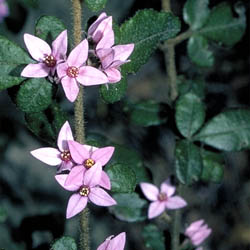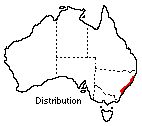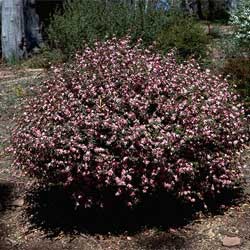Boronia mollis
 |
|
Boronia mollis A.Cunn. ex Lindl.
Boronia mollis is a variable shrub which may grow to about 3 m high and 1.5 m wide in its natural habitat. It occurs naturally around Sydney, ranging as far north as Coffs Harbour and inland as far as the Dividing Range. It is found growing in cool, shady situations, frequently on creek banks or the border of rain forests. In these situations it is often a tall straggly shrub, sparsely flowering where it reaches toward the sun.
 The
specimens growing in the Australian National Botanic Gardens are from a clone
collected near Lorne, west of Laurieton, NSW. The original plant was a densely
branched specimen 1.5 m x 1.5 m growing in full sun on the top of an exposed
ridge. This habit has been maintained by the progeny and a plant of outstanding
horticultural merit has resulted.
The
specimens growing in the Australian National Botanic Gardens are from a clone
collected near Lorne, west of Laurieton, NSW. The original plant was a densely
branched specimen 1.5 m x 1.5 m growing in full sun on the top of an exposed
ridge. This habit has been maintained by the progeny and a plant of outstanding
horticultural merit has resulted.
The leaves are pinnate and the under-surface and stems are covered with fine hairs. The leaves possess glands which emit a pungent volatile oil when crushed. This is characteristic of the family Rutaceae to which Boronia belongs. It has been suggested that the scent from this oil protects the plant from herbivorous animals.
The flowers, which are produced in abundance from late winter through spring and occasionally throughout the year, are deep pink and the short stamens are bright yellow. The flowers form in clusters in the axils of the leaves and have four petals and eight stamens with two small bracts on the flower stalk.
The plants growing in the Australian National Botanic Gardens have an easterly aspect and are growing in the rocky, natural soil of Black Mountain. All plants have been mulched and are growing amongst Eucalyptus rossii and Eucalyptus macrorhyncha which provide mottled shade for various periods during the day. The plants are rounded in habit and bushy to the ground, ranging in height up to 2 m. One large plant has been staked to protect it from wind damage. All plants have been fertilised with a complete fertiliser and watered regularly during the summer months.
Boronias are subject to root rot and thus a well-drained soil is needed to prevent conditions favourable to this fungus. In general, a light, sandy loam is best with a surface mulch to provide a cool root run. This particular form can take more sun than most Boronia species but some protection from drying summer winds should be given. Excessive watering should be avoided as these plants prefer capillary moisture from below. Propagation is by cuttings taken in summer and few insect pests have been noticed.
Text by ANBG staff (1976)
Name meaning: Boronia mollisBoronia - after Francesco Borone, a plant collector of the 18th century; mollis - Latin for soft or hairy, referring to the leaves and stems
|
![An Australian Government Initiative [logo]](/images/austgovt_brown_90px.gif)


